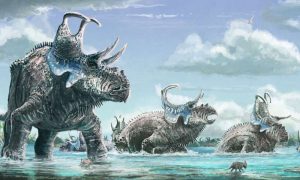
An international team of scientists, including a graduate student lead author from Ohio University, have identified a new species of centrosaurine, a member of the large-bodied ceratopsians (horned dinosaurs) that diversified in North America and Asia during the final stages of the age of dinosaurs.
Although many fossils of this group have been discovered in North America, particularly from the northern portion of the Cretaceous landmass Laramidia (Alaska, Alberta, Montana, and Saskatchewan), relatively few have been recovered from the southern portion (Utah, Colorado, New Mexico, Texas, and Mexico) of this ancient continent.
The new species, named Machairoceratops cronusi (UMNH VP 20550), was discovered by scientists conducting paleontological and geological surveys in Grand Staircase-Escalante National Monument, southern Utah. With the help of professional excavators and volunteers from Ohio University and the Natural History Museum of Utah (NHMU), the team unearthed the characteristic horncores and other skull elements over the course of three field seasons.
Comparisons with other horned dinosaurs revealed unique features, indicating the animal was different from other horned dinosaurs—including those from elsewhere in Utah, according to a study the team published today in PLOS ONE. Lead author and Ohio University graduate student Eric Lund stated “The discovery of Machairoceratops not only increases the known diversity of ceratopsians from southern Laramidia, it also narrows an evolutionary information gap that spans nearly 4 million years between Diabloceratops eatoni from the lower middle Wahweap Formation and Nasutoceratops titusi from the overlying Kaiparowits Formation “.
Machairoceratops lived approximately 77 million years ago during the end of the Cretaceous Period, a time when North America was subdivided by an epicontinental sea (one within a continent) into western (Laramidia) and eastern (Appalachia) landmasses. Centrosaurine ceratopsids, the group that includes Machairoceratops, were herbivorous dinosaurs known for their iconic, parrot-like beaks, enlarged noses, facial horns, and ornamented frills (neck shields). Machairoceratops is estimated to have been 6–8 meters long and may have weighed as much as 1–2 tons.
The skull of the new species exhibits similarities with the only other centrosaurine (Diabloceratops) yet named from southern Laramidia. But the two southern dinosaurs are distinctly different from one another, and, most notably, quite distinct from centrosaurines known from northern Laramidia. “Machairoceratops is unique in possessing two large, forward curving spikes off of the back of the neck shield, each of which is marked by a peculiar groove extending from the base of the spike to the tip, the function of which is currently unknown,” remarked Eric Lund.
In addition to expanding the diversity of centrosaurine ceratopsid frill ornamentation, this study also provides important insights into the early evolutionary history of ceratopsids on Laramidia. The discovery of Machairoceratops bolsters the idea that ceratopsians occupied two distinct regions that were latitudinally separated within Laramidia, and suggests that different evolutionary pressures acted upon the groups during the late Cretaceous.
“An effort like this underscores both the necessity and excitement of basic, exploratory science in order to better understand the history of the world around us,” noted study co-author Patrick O’Connor, professor of anatomical sciences at the Heritage College of Osteopathic Medicine. “Even in a place like western North America, where intense work has been conducted over the past 150 years, we are still finding species new to science,” he added.
Others authors on the study include paleontologist Mark Loewen, a research associate at the Natural History Museum of Utah, and geologist Zubair Jinnah, a senior lecturer at University of the Witwatersrand in Johannesburg, South Africa.
The study was funded by the Bureau of Land Management (Grand Staircase-Escalante National Monument), the Ohio University Heritage College of Osteopathic Medicine, the Ohio University Office of the Vice President for Research and Creative Activity, and the US National Science Foundation. Eric Lund has previously co-authored another study describing another new ceratopsid dinosaur Nasutoceratops titusi, also from the Late Cretaceous of Utah.
Reference:
Lund EK, O’Connor PM, Loewen MA, Jinnah ZA (2016) A New Centrosaurine Ceratopsid, Machairoceratops cronusi gen et sp. nov., from the Upper Sand Member of the Wahweap Formation (Middle Campanian), Southern Utah. PLoS ONE 11(5): e0154403. DOI: 10.1371/journal.pone.0154403
Note: The above post is reprinted from materials provided by Ohio University.










